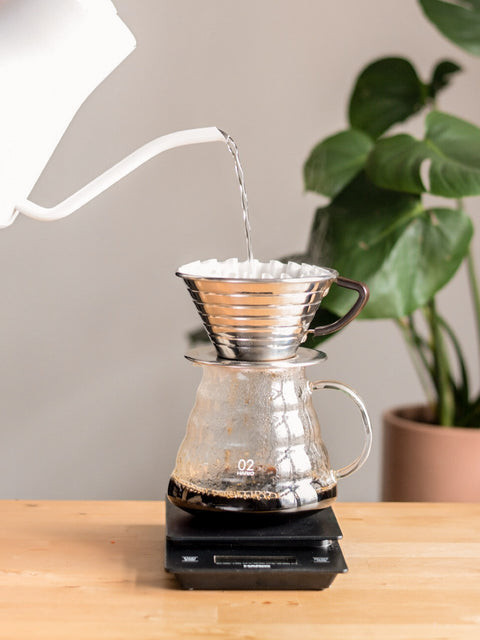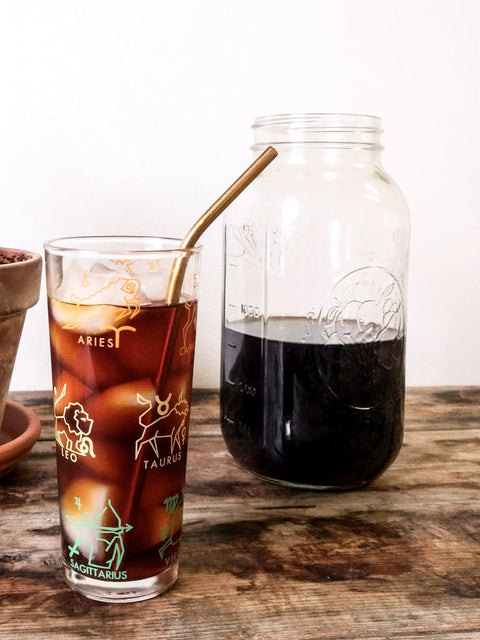From Our Café to Your Kitchen
We believe great coffee doesn't stop at the café. We're proud to share the recipes and know-how behind our brews so you can make the most of every cup at home. Whether you're a longtime regular or just getting into specialty coffee, these guides are here to help you brew with confidence.
Below are our tried-and-true brewing fundamentals — the elements that make the biggest difference in flavor, texture, and balance. Tap or click each section to explore what’s behind a better brew. These aren’t rigid rules, just thoughtful practices we’ve learned from decades of making (and drinking) a lot of coffee.
Quality
Coffee is roughly 98% water and 2% soluble plant matter, so the water you brew with makes a difference. Use filtered, but not distilled, water. A little mineral content helps coffee extract properly. Hard water often extracts better than soft water — but if your water is too hard or too soft, it can throw off the taste. Filtered tap water (via a charcoal filter like Brita) usually hits the sweet spot.
Temperature
Water that’s too hot or too cold can skew your brew. For hot coffee, aim for 195–205°F (91–96°C), or about 30 seconds off boil — the ideal range for extracting the best tasting balance of sweet and acidic flavors.
For cold brew, room temperature works best: 60–75°F (15–24°C). Cold water slows down extraction, which helps bring out smooth, mellow flavors. Warmer water speeds things up, but can lead to bitterness if steeped too long.
Fresh Ground vs. Pre-Ground
Freshly ground coffee gives you a more flavorful and aromatic cup because whole beans hold onto volatile compounds — like oils and aromatics — much longer than pre-ground coffee. Oxygen, heat, and moisture start breaking those down as soon as the coffee is ground.
Don’t have a grinder? That’s okay! Start with good quality, freshly roasted coffee, and follow the rest of these tips — you can still get a great cup.
Blade Grinders vs. Burr Grinders
- Blade grinders are affordable but chop beans unevenly, producing a mix of large chunks and fine dust. That inconsistency leads to uneven extraction — some coffee overbrews, some underbrews, and the result can taste muddy or off-balance.
- Burr grinders crush beans between two surfaces, producing a more uniform grind size. This means more control, more consistency, and ultimately, a more balanced and expressive cup. They're an investment, but one of the most impactful upgrades for brewing at home.
Grind Size
Matching the grind size to your brew method is essential. Too coarse, and you risk sour or weak coffee (under-extracted). Too fine, and you risk bitterness and dryness (over-extracted). Each method has a sweet spot: espresso needs a fine grind; French press needs coarse. This is one of the most tweakable variables — and one of the most rewarding to dial in.
The ratio of coffee to water sets the stage for your brew — it’s the baseline for how strong, sweet, or balanced your cup will taste. Most brew methods fall into a range between 1:15 and 1:18 (that’s 1 gram of coffee to 15–18 grams of water by weight).
- 1:15 yields a stronger, more concentrated cup.
- 1:18 produces a lighter, more delicate brew.
Your ideal ratio depends on your method, roast level, and personal taste. A digital scale makes it easy to experiment and repeat what you like — it’s less about being “perfect” and more about finding your version of just right.
How you brew shapes the outcome. The gear you use determines grind size, filtration, contact time, and even the texture of your coffee. For example:
- French Press produces a heavier-bodied cup, thanks to its metal mesh screen and full immersion brewing. Unlike paper filters, the mesh allows oils and fine particles into the final cup, contributing to a denser, more textured mouthfeel. The coffee also steeps for several minutes in hot water, pulling out more soluble compounds that add to the richness.
- Pour over methods use a paper filter and a controlled pour, creating a cleaner, brighter brew. The paper removes oils and fines, and the flow-through style highlights more delicate acidity and clarity in the cup.
Each method emphasizes different aspects of the coffee — body, brightness, texture, or sweetness. There's no single “best” way to brew; just the best way for what you're after.
Tasting is how you know if your brew is dialed in. If your coffee tastes sharp, sour, or weak, it might be under-extracted — meaning it didn’t brew long enough or needs a finer grind. If it tastes bitter, dry, or harsh, it may be over-extracted — meaning it brewed too long or the grind is too fine.
It’s easy to get caught up in ratios, timers, and settings, but the real feedback comes from your own palate. The more you taste and tweak, the more intuitive brewing becomes. Your taste will guide you better than any recipe.
Pourover
A versatile recipe for single serving pourover brew methods, whether a V60, Kalita, or anywhere in between.
TOOLS: Pourover brewer, filter, server, pouring kettle, scale and timer.
WATER: 400g @ 205°F (96°C)
GRIND: Medium-coarse (similar to rough sand)
DOSE: 28g whole bean, 25g ground
YIELD: 12 ounces
- Place filter in brewer, and place on server. Rinse filter with hot water until brewer feels warm. Pour hot rinse water out.
- Adjust grinder to a medium-coarse setting, similar in texture to rough sand. Measure and grind a 28g dose (4Tbsp) of whole bean coffee.
- Place brewer and server on scale and tare, and add 25g ground coffee. Tare scale again, and level grounds by gently shaking.
- Start timer and add 50g water, taking care to saturate all coffee grounds. Allow coffee to "bloom" for 30 seconds.
- When the timer hits :30, add water to 150g, pouring in a circular motion starting at the center and moving outward, then back to center. Avoid pouring down the sides of the coffee bed or onto the filter.
Repeat every 45 seconds, 2 times. (At 1:15, add water to 250g; at 2:00, add water to 350g) - When the timer hits 2:45, add water to 400g. Coffee should finish draining within 4 minutes and grounds should be level when done. Swirl coffee and serve.
Pro Tips:
- If your coffee takes longer than 5 minutes to drain out, try a coarser grind setting.
- If your coffee drains faster than 3.5 minutes, try a finer grind setting.
French Press
A classic French Press recipe, yeilding a rich flavorful cup of coffee.
TOOLS: 34 oz French Press, pouring kettle, scale, timer, and spoon.
WATER: 800g @ 205°F (96°C)
GRIND: Coarse (similar to sea salt)
DOSE: 56g whole bean, 53g ground
YIELD: 26 ounces
- Pour a few inches of hot water into the French Press. Move the plunger up and down to preheat the press and flush away any residual oils. Pour this water out.
- Adjust grinder to a coarse setting, similar to sea salt. Measure and grind a 59g dose (7.5Tbsp) of whole bean coffee.
- Place French Press on scale, tare, and add 56g ground coffee. Shake French Press gently to level grounds, and tare scale again.
- Start timer and begin adding water, making sure to wet all grounds. Stop filling when scale reads 800g (27oz), or when water is about 2" from the top of the press. Finish pouring before timer hits 0:45, then allow the slurry to "bloom".
- When timer reaches 1:15 use the back of the spoon to gently dunk the crust. Cover with lid and steep.
- When timer reaches 4:00, push the plunger down slowly to the bottom. Decant into server to halt extraction. Swirl coffee and seve.
Pro Tips:
- If it is too difficult to press the plunger, and your coffee is sludgy, try a coarser grind.
- If it is too easy to press the plunger, and your coffee is thin, try a finer grind.
- If you're having a hard time getting all of your grounds wet quickly, try spinning the french press as you pour.
Cold Brew
A simple cold brew recipe using a French Press, creating a concentrate perfect for mixing with water or milk.
TOOLS: 8 cup or larger French Press, paper filter, decanter, scale and timer
WATER: Room temperature
GRIND: Coarse (similar to sea salt)
DOSE: 135g whole bean / 130g ground
YIELD: 25 oz concentrate, 50 oz cut cold brew
- Adjust grinder to coarse setting. Measure and grind 135 gram dose (tbs) of whole bean coffee.
- Add 130g ground coffee to French Press. Pour 945g (cups) of room temperature water into French Press.
- Stir, saturating all of the grounds.
- Gently place plunger on top of French Press, but do not plunge. Let coffee and water mixture steep for 10-12 hours.
- After 10-12 hours, plunge down French Press to hold grounds at the bottom.
- Set up paper filter and decanter. Rinse paper filter with fresh water and dump to remove paper flavor. Strain cold brew concentrate through filter to catch remaining fines.
- Dilute concentrate to taste. We recommend a 1:1 water to coffee ratio. Serve and enjoy!
- Store in refrigerator for up to 1 week.
Pro Tip:
If you do not have a French Press, other vessels can be used as alternatives. Just be sure to follow the recipe and filter well!
Troubleshooting Your Brew
Not every cup comes out perfect — and that’s part of the process.
Below are common brew issues and simple adjustments that can help you get back on track. Tap or click to reveal fixes based on taste, texture, or appearance.
Under-extracted. Try a finer grind, longer brew time, or slightly hotter water. Sourness often means you didn’t pull enough sweetness and body from the coffee
Over-extracted. Try a coarser grind, shorter brew time, or slightly cooler water. Bitterness can come from drawing out too many compounds from the coffee.
Check your brew ratio — you may need more coffee. Also double-check grind size and contact time; too coarse or too fast a brew won’t extract enough flavor.
This could be too much coffee, too fine a grind, or an immersion method (like French press) left brewing too long. Try scaling back your dose, coarsening your grind, or reducing steep time.




